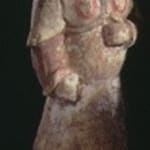Pair of Tang Polychrome Military Officials, 618 CE - 906 CE
Terracotta
4.25 x 14.25
H.046a
Typically among the largest of burial figurines, military men are often depicted in exquisite detail. They comprise of the various guardian figures whose main purpose was to watch over the...
Typically among the largest of burial figurines, military men are often depicted in exquisite detail. They comprise of the various guardian figures whose main purpose was to watch over the burial site and protect the deceased. The figures wear matching battle attire consisting of sectioned chest plates with red circular designs, elbow-length shoulder plates protruded by red sleeves, and a draping headdress topped with a bulbous crown. Beneath the chest armor, they wear three-quarter length robes tied at the waist and baggy pantalones. Both figures assume the ready position gesturing with their hands that they once held weapons. As with many fine pottery figurines, the distinguishing characteristic of a piece is the personal rendering of facial features and expressions. One figure's face is painted red with distinctively menacing traits while the other figure appears attentive and reserved. In order to achieve a life-like presence, the artisan strove to imbue each figurine with a unique quality, so that despite mass produced methods, no two pieces were identical. The subject of tomb figures is closely linked with Chinese religion and philosophy. The tomb signified a gate to the afterlife or a meeting place of the two worlds. Pottery figurines replaced the Eastern Zhou tradition of interring live persons, animals and actual objects.



